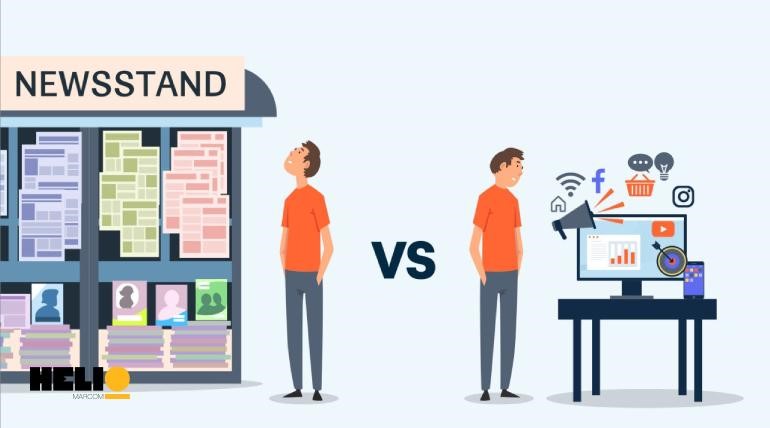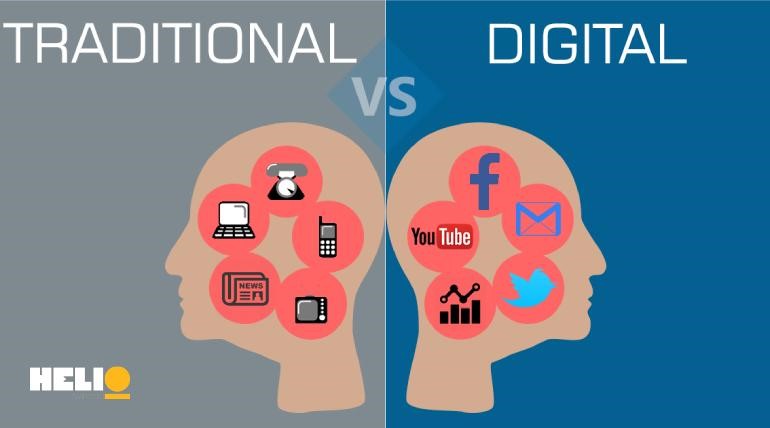Marketing is the lifeblood of any business, driving growth, building brand awareness, and engaging with customers. Traditionally, marketing was confined to print ads, television and radio broadcasts, and direct mail campaigns. However, with the rise of the Internet, digital marketing has emerged as a powerful force in the business world.
Understanding the benefits of traditional vs. digital marketing is crucial for modern businesses. Selecting the right strategy can make or break your efforts to reach your target audience effectively and efficiently. This post will delve into the advantages of digital marketing over traditional methods, providing clear, precise guidance to help you make informed decisions. Join Helio to discover the benefits of digital marketing.
What Are Traditional Marketing and Digital Marketing?
Traditional marketing encompasses time-honored methods such as print advertisements, television commercials, radio spots, and direct mail campaigns. These strategies have been cornerstones of business promotion for decades, establishing brand presence and reaching broad audiences.
Conversely, digital marketing leverages online platforms and technologies to connect with customers. Techniques such as search engine optimization (SEO), pay-per-click (PPC) advertising, content marketing, social media engagement, and email campaigns define this modern approach. Both forms of marketing have played significant roles in business growth, yet their relevance and effectiveness continue to evolve.
Importance of Understanding the Benefits of Each for Modern Businesses
For contemporary businesses, recognizing the strengths and limitations of both traditional and digital marketing is critical. An integrated marketing strategy can harness the unique advantages of each approach, maximizing reach and impact in an increasingly competitive marketplace.
What is Traditional Marketing: A Historical Perspective
Traditional marketing refers to the conventional strategies employed before the advent of the Internet. Examples include:
- Newspaper Ads: Print ads placed in newspapers to target local readerships.
- Billboards: Large outdoor advertisements designed to capture the attention of passersby.
- TV Commercials: Broadcast advertisements aired during television programs to reach mass audiences.
- Radio Spots: Audio ads broadcasted on radio stations to engage listeners.
- Direct Mail: Physical mail sent to potential customers’ addresses, including catalogs and promotional materials.
Historical Effectiveness and Limitations
Historically, traditional marketing has effectively driven consumer behavior and built brand awareness. TV commercials and print ads have the power to create memorable brand impressions, while billboards and radio spots offer broad visibility.
However, traditional marketing faces notable limitations. High costs, limited audience targeting, and difficulty measuring ROI pose challenges. Additionally, these methods often lack the immediacy and engagement digital platforms provide.
Advantages of Traditional Marketing Over Digital Marketing
Despite the rise of digital marketing, traditional methods still hold value. They are particularly effective in local markets, for audiences less engaged with digital platforms, and in industries where trust and credibility are paramount.
Brief Analysis of Current Relevance in the Digital Age
Despite the surge of digital marketing, traditional methods retain relevance in specific contexts. Local businesses, luxury brands, and industries catering to less digitally savvy demographics may find traditional marketing beneficial. However, the digital age demands a more agile and data-driven approach to marketing.
What is Digital Marketing: The Game Changer
Digital marketing encompasses all marketing efforts that use the internet or an electronic device. Businesses leverage digital channels like search engines, social media, email, and websites to connect with current and prospective customers.
From the early days of email marketing to the complex, multi-channel campaigns of today, digital marketing has evolved rapidly. Innovations like social media, influencer collaborations, and sophisticated data analytics have transformed how businesses interact with their audiences.
Digital marketing encompasses a range of strategies that leverage online channels to engage audiences. Key approaches include:
- Search Engine Optimization (SEO): Enhancing website visibility on search engines to attract organic traffic.
- Pay-Per-Click (PPC) Advertising: Paid ads on platforms such as Google Ads, where advertisers pay for each click on their ad.
- Content Marketing: Creating valuable and relevant content to attract and retain customers.
- Social Media Marketing: Utilizing social media platforms to connect with audiences and promote products or services.
- Email Marketing: Sending targeted emails to nurture leads and maintain customer relationships.
Real-World Examples of Successful Digital Marketing Campaigns
Digital marketing boasts numerous success stories. For instance, Airbnb’s “Live There” campaign utilized social media and influencer marketing to promote local travel experiences, increasing bookings and brand engagement. Similarly, Dollar Shave Club’s viral video ad garnered millions of views, driving significant growth for the subscription-based business.
Benefits of Digital Marketing Over Traditional Marketing in Reaching Target Audiences
Digital marketing offers considerable advantages over traditional marketing, particularly in industries that demand precise targeting and measurable outcomes. For example, understanding the advantages of digital marketing in the aviation industry highlights how companies can leverage online platforms to reach a global audience, engage travelers, and streamline operations efficiently. Advanced analytics enable businesses to segment audiences based on specific needs, such as frequent fliers or budget travelers, ensuring campaigns resonate effectively.
Digital marketing provides unparalleled precision in audience targeting. Techniques such as demographic segmentation, behavioral analysis, and interest-based targeting ensure that marketing messages connect with the right audience, enhancing engagement and conversion rates.

Digital vs. Traditional: What Makes Digital Marketing Different from Traditional Marketing
Digital marketing is highly cost-effective; businesses can choose their budget and pay only for the desired outcomes. PPC ads, for instance, are billed based on clicks, while social media ads can be targeted to specific budget caps.
The most significant advantage of digital marketing lies in its measurability. Online platforms provide extensive data on campaign performance metrics such as website visits, leads generated, and conversions. Businesses can analyze this data to refine their strategies continually and optimize ROI.
Detailed Cost Comparison Between Traditional and Digital Marketing
Traditional marketing often entails substantial costs. TV commercials, especially during prime time, require significant investments. Print ads in major publications and extensive billboard campaigns also come at a high price. Direct mail campaigns involve printing and postage expenses.
In contrast, digital marketing offers cost-effective options. PPC campaigns allow businesses to set budgets and pay only when users click on their ads. Content marketing and social media strategies can be executed with relatively modest budgets. The ability to control costs and allocate resources efficiently makes digital marketing attractive for businesses of all sizes.
Discussion on the Importance of Return on Investment (ROI) and Measurability
Measuring ROI is essential for evaluating marketing effectiveness. Traditional marketing’s ROI is challenging to quantify. While impressions and reach can be estimated, determining the direct impact on sales and conversions remains difficult.
Digital marketing, however, excels in measurability. Tools like Google Analytics, Facebook Insights, and email marketing platforms provide detailed metrics on user interactions, website traffic, conversion rates, and more. This data-driven approach enables businesses to assess campaign performance, refine strategies, and continually optimize ROI.
How Digital Marketing Allows for Precise Audience Targeting
One of digital marketing’s greatest strengths is its ability to precisely target specific audiences. Techniques such as:
- Demographic Targeting: Reaching users based on age, gender, income, and education.
- Interest-Based Targeting: Engaging individuals with specific hobbies, preferences, and interests.
- Behavioral Targeting: Identifying users based on their online behaviors, such as browsing history and purchase patterns.
These techniques ensure marketing efforts are directed toward the most relevant audience segments, maximizing impact and minimizing wasted resources.
The Role of Personalization in Improving Customer Engagement and Conversion Rates
Personalized marketing messages resonate deeply with customers, fostering stronger connections and higher conversion rates. Digital marketing facilitates personalization through the following:
- Dynamic Website Content: Tailoring website content based on user preferences and past interactions.
- Personalized Emails: Sending targeted emails with customized offers, recommendations, and greetings.
- Retargeting Ads: Displaying ads to users who have previously interacted with the brand, encouraging them to return and complete desired actions.
Personalization enhances customer experience, builds loyalty, and drives repeat business.
Global Reach and 24/7 Accessibility
Digital marketing transcends geographical boundaries, enabling businesses to reach a global audience effortlessly. Whether a small e-commerce store or a multinational corporation, the internet provides a platform to connect with potential customers worldwide.
Platforms such as social media, search engines, and e-commerce websites facilitate international marketing campaigns. Brands can showcase their products and services to diverse audiences, expanding market reach and driving growth.
Discussion on Accessibility and Convenience for Businesses and Consumers
Digital marketing offers unparalleled accessibility and convenience for both businesses and consumers. Online campaigns run 24/7, allowing brands to engage with customers anytime. Consumers can explore products, make purchases, and interact with brands from the comfort of their homes.
This accessibility fosters continuous engagement and strengthens brand-consumer relationships. Businesses can respond to inquiries, address concerns, and provide real-time support, enhancing customer satisfaction and loyalty.
How Digital Marketing Can Quickly Adapt to Market Trends and Consumer Behavior
The digital landscape is dynamic and characterized by rapid changes in trends and consumer behavior. Digital marketing’s flexibility allows businesses to adapt swiftly. Strategies can be adjusted in real time based on performance data and market insights.
For example, businesses can tweak content, targeting, and ad placements to improve results if a social media campaign is underperforming. This agility ensures that marketing efforts remain relevant and effective in a constantly evolving environment.
The Inflexibility of Traditional Methods in Making Quick Adjustments
Traditional marketing methods, in contrast, lack the flexibility to respond rapidly to market changes. Making alterations can be time-consuming and costly once a print ad or TV commercial is published. This rigidity can result in missed opportunities and reduced campaign effectiveness.
Examples of missed opportunities abound. A billboard campaign launched six months ago may no longer resonate with consumer preferences. Digital marketing’s ability to adapt quickly provides a significant competitive edge.
Final Thoughts on Why Businesses Should Incorporate Digital Marketing
In summary, while traditional marketing has played a vital role in business promotion, digital marketing offers numerous advantages in today’s digital age. From cost-effectiveness and precise targeting to global reach and real-time adaptability, digital strategies empower businesses to connect with their audiences more effectively. If you need; We can informed you about digital marketing cost in dubai .
Incorporating digital marketing into your business strategy is no longer optional—it’s imperative. The benefits of Internet marketing over traditional methods are straightforward. Businesses that embrace digital marketing position themselves for growth, competitiveness, and long-term success.
Consider Helio Digital Marketing Strategies
Ready to elevate your marketing game? Explore the transformative potential of digital marketing with Helio advertising agency. Our expert team offers tailored strategies to help your business thrive digitally. Contact us today to embark on a journey toward marketing excellence.
By adopting digital marketing, you not only enhance your brand’s visibility but also drive meaningful engagement and achieve measurable results. Embrace the future of marketing—embrace Helio.
FAQs
What is the difference between digital marketing and traditional marketing?
Digital marketing utilizes online channels, while traditional marketing relies on offline media.
Why is digital marketing more cost-effective?
Digital marketing allows for precise targeting and performance tracking, reducing wasted spend.
Can traditional and digital marketing be integrated?
Yes, combining both strategies can maximize reach and impact.





